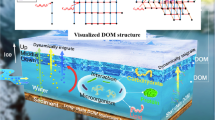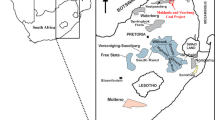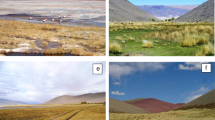Abstract
Based on gas chromatography and gas chromatography-mass spectrometry analyses, an amazing amount of hopanoids was detected in the peat deposits in the Dajiuhu National Wetland Park in central China. The hopanoids identified included hopanes (C27-C31 αβ, C27-C32 ββ, C29 βα), hopenes (hop-22(29)-ene, 22,29,30-trinorhop-17(21)-ene, hop-17(21)-ene, hop-13(18)-ene, etc.), hopanoic acids (C31-C34 ββ, C32-C33 βα, C32 αβ), hopanols (C32 ββ and αβ) and hopanone (22,29,30-trinorhop-21-one). C31 αβ-22R hopane was found to be the dominant hopanoid, more abundant than individual nalkanes derived from higher plants. These hopanoids, exclusive of some hopenes, are proposed to be primarily from bacteria. The dominant C31 αβ-22R hopane in young sediments, without any thermal maturation, might be formed through microbial epimerization under acidic conditions in the peatland as suggested before, or directly from aerobic bacteria. This finding highlights the importance of microbes in the formation of peatland as well as in the reconstruction of paleoenvironments.
Similar content being viewed by others
References
Ageta H, Arai Y (1983). Fern constituents: pentacyclic triterpenoids isolated from Polypodium niponicum and P. formosanum. Phytochemistry, 22: 1801–1808
Barakat A O, Yen T F (1990). Distribution of pentacyclic triterpenoids in Green River oil shale kerogen. Organic Geochemistry, 15: 299–311
Barber K E, Chambers F M, Maddy D, Stoneman R, Brew J S (1994). A sensitive high-resolution record of late Holocene climatic change from a raised bog in northern England. The Holocene, 4: 198–205
Blackford J J, Chambers F M (1995). Proxy climate record for the last 1000 years from Irish blanket peat and a possible link to solar variability. Earth and Planetary Science Letters, 133: 145–150
Blyth A J, Baker A, Collins MJ, Penkman K E H, Gilmour MA, Moss J S, Genty D, Drysdale R N (2008). Molecular organic matter in speleothems and its potential as an environmental proxy. Quaternary Science Reviews, 27: 905–921
Chambers F M, Mauquoy D, Brain S A, Blaauw M, Daniell J R G (2007). Globally synchronous climate change 2800 years ago: Proxy data from peat in South America. Earth and Planetary Science Letters, 253: 439–444
Dehmer J (1993). Petrology and organic geochemistry of peat samples from a raised bog in Kalimantan (Borneo). Organic Geochemistry, 20: 349–362
Dehmer J (1995). Petrological and organic geochemical investigation of recent peats with known environments of deposition. International Journal of Coal Geology, 28: 111–138
Duan Y, Ma L H (2001). Lipid geochemistry in a sediment core from Ruoergai Marsh deposit (Eastern Qinghai-Tibet plateau, China). Organic Geochemistry, 32: 1429–1442
Eglinton G, Hamilton R J (1967). Leaf Epicuticular Waxes. Science, 156: 1322–1335
Evershed R P, Volders F D M, Xie S C, Nott C J, Avesjes L A, Maddy D, Chambers F M, Gledhill A, Carter J F (2001). Palaeoclimate records in compound-specific delta D values of lipid biomarkers in ombrotrophic peat. Abstracts of Papers of the American Chemical Society, 221: 535–535
Farrimond P, Flanagan R L (1996). Lipid stratigraphy of a Flandrian peat bed (Northumberland, UK): Comparison with the pollen record. Holocene, 6: 69–74
Ficken K J, Barber K E, Eglinton G (1998). Lipid biomarker, delta C-13 and plant macrofossil stratigraphy of a Scottish montane peat bog over the last two millennia. Organic Geochemistry, 28: 217–237
Flesch G, Rohmer M (1989). Prokaryotic triterpenoids. A novel hopanoid from the ethanol-producing bacterium Zymomonas mobilis. Biochemical Journal, 262: 673–675
Hong Y T, Jiang H B, Liu T S, Zhou L P, Beer J, Li H D, Leng X T, Hong B, Qin X G. (2000). Response of climate to solar forcing recorded in a 6000-year delta O-18 time-series of Chinese peat cellulose. Holocene, 10: 1–7
Huang X, Jiao D, Lu L Q, Xie S C, Huang J H, Wang Y B, Yin H F, Wang HM, Zhang K X, Lai X L (2007). The fluctuating environment associated with the episodic biotic crisis during the Permo/Triassic transition: Evidence from microbial biomarkers in Changxing, Zhejiang Province. Science in China Series D-Earth Sciences, 50: 1052–1059
Huang X Y, Cui J W, Pu Y, Huang J H, Blyth A J (2008)a. Identifying “free” and “bound” lipid fractions in stalagmite samples: An example from Heshang Cave, Southern China. Applied Geochemistry, 23: 2589–2595
Huang X Y, Me S C, Zhang C L L, Jiao D, Huang J H, Yu J X, Jin F, Gu Y S (2008)b. Distribution of aliphatic des-A-triterpenoids in the Dajiuhu peat deposit, southern China. Organic Geochemistry, 39: 1765–1771
Ise T, Dunn A L, Wofsy S C, Moorcroft P R (2008). High sensitivity of peat decomposition to climate change through water-table feedback. Nature Geoscience, 1: 763–766
Jansen B, Haussmann N S, Tonneijck F H, Verstraten J M, Voogt P de (2008). Characteristic straight-chain lipid ratios as a quick method to assess past forest-paramo transitions in the Ecuadorian Andes. Palaeogeography Palaeoclimatology Palaeoecology, 262: 129–139
Kawamura K, Suzuki I, Fujii Y, Watanabe O (1996). Ice core record of fatty acids over the past 450 years in Greenland. Geophysical Research Letters, 23: 2665–2668
Kylander M E, Muller J, Wust R A J, Gallagher K, Garcia-Sanchez R, Coles B J, Weiss D J (2007). Rare earth element and Pb isotope variations in a 52 kyr peat core from Lynch,s Crater (NE Queensland, Australia): proxy development and application to paleoclimate in the Southern Hemisphere. Geochimica Et Cosmochimica Acta, 71: 942–960
Luo G M, Xie S C, Wu J, Sun S, Huang J H, Shi X Y (2008). Molecular Evidence for Primary Producers and Paleo-environmental Conditions in Mesoproterozoic in the Xuanlong Depression in North China. Journal of China University of Geosciences, 19: 567–576
Ma C M, Zhu C, Zheng C G, Wu C L, Guan Y, Zhao Z P, Huang L Y, Huang R (2008). High-resolution geochemistry records of climate changes since late-glacial from Dajiuhu peat in Shennongjila Mountains, central China. Chinese Science Bulletin, 53: 28–41
Makou MC, Hughen K A, Xu L, Sylva S P, Eglinton T I (2007). Isotopic records of tropical vegetation and climate change from terrestrial vascular plant biomarkers preserved in Cariaco Basin sediments. Organic Geochemistry, 38: 1680–1691
Mauquoy D, Engelkes T, Groot M H M, Markesteijn F, Oudejans M G, van der Plicht J, Geel B van (2002). High-resolution records of late-Holocene climate change and carbon accumulation in two north-west European ombrotrophic peat bogs. Palaeogeography Palaeoclimatology Palaeoecology, 186: 275–310
Meyers P A, Ishiwatari R (1993). Lacustrine organic geochemistry-an overview of indicators of organic matter sources and diagenesis in lake sediments. Organic Geochemistry, 20: 67–900
Meyers P A, Lallier-Verges E (1999). Lacustrine sedimentary organic matter records of Late Quaternary paleoclimates. Journal of Paleolimnology, 21: 345–372
Nott C J, Xie S C, Avsejs L A, Maddy D, Chambers F M, Evershed R P (2000). n-Alkane distributions in ombrotrophic mires as indicators of vegetation change related to climatic variation. Organic Geochemistry, 31: 231–235
Ourisson G, Rohmer M (1982). Prokaryotic polyterpenes: phylogenetic precursors of sterols. In: Bornner F, Kleinzeller A, eds. Current Topics in Membranes and Transport Vol. 17, Membrane Lipids of Prokaryloes, New York: Academic Press, 153–182
Ourisson G, Rohmer M, Poralla K (1987). Prokaryotic hopanoids and other Polyterpenoid sterol surrogates. Annual Review of Microbiology, 41: 301–333
Pancost R D, Baas M, van Geel B, Damste J S S (2002). Biomarkers as proxies for plant inputs to peats: an example from a sub-boreal ombrotrophic bog. Organic Geochemistry, 33: 675–690
Pancost R D, Baas M, van Geel B, Sinninghe Damste J S (2003). Response of an ombrotrophic bog to a regional climate event revealed by macrofossil, molecular and carbon isotopic data. The Holocene, 13: 921–932
Pancost R D, Boot C S (2004). The palaeoclimatic utility of terrestrial biomarkers in marine sediments. Marine Chemistry, 92: 239–261
Pancost R D, van Geel B, Baas M, Damste J S S (2000). Delta C-13 values and radiocarbon dates of microbial biomarkers as tracers for carbon recycling in peat deposits. Geology, 28: 663–666
Pu Y, Huang J H, Huang X Y, Cui JW, Hu C Y (2006). Acyclic alkanes in the soil over heshang cave in Qingiiang, Hubei province. Journal of China University of Geosciences, 17: 115–120
Quirk M M, Wardroper A M K, Wheatley R E, Maxwell J R (1984). Extended hopanoids in peat environments. Chemical Geology, 42: 25–43
Ries-Kautt M, Albrecht P (1989). Hopane-derived triterpenoids in soils. Chemical Geology, 76: 143–151
Rohmer M, Bouvier-Nave P, Ourisson G (1984). Distribution of hopanoid triterpenes in prokaryotes. Microbiology, 130: 1137–1150
Rohmer M, Dastillung M, Ourisson G (1980). Hopanoids from C30 to C35 in recent muds. Naturwissenschaften, 67: 456–458
Rosa-Putra S, Nalin R, Domenach A M, Rohmer M (2001). Novel hopanoids from Frankia spp. and related soil bacteria-Squalene cyclization and significance of geological biomarkers revisited. European Journal of Biochemistry, 268: 4300–4306
Shi J Y, Xiang M J, Hong Z Q, Ling S J, Zhou Q Y (1991). Source and evolution of de-A-lupenes and some pentacyclic triterpanoids. Acta Sedimentologica Sinica, 9: 26–33 (in Chinese with English abstract)
Shotyk W, Krachler M, Martinez-Cortizas A, Cheburkin A K, Emons H (2002). A peat bog record of natural, pre-anthropogenic enrichments of trace elements in atmospheric aerosols since 12 370 C-14 yr BP, and their variation with Holocene climate change. Earth and Planetary Science Letters, 199: 21–37
Shunthirasingham C, Simpson M J (2006). Investigation of bacterial hopanoid inputs to soils from Western Canada. Applied Geochemistry, 21: 964–976
Summons R E, Jahnke L L, Roksandic Z (1994). Carbon isotopic fractionation in lipids from methanotrophic bacteria-relevance for interpretation of the geochemical record of biomarkers. Geochimica Et Cosmochimica Acta, 58: 2853–2863
Talbot H M, Summons R E, Jahnke L L, Cockell C S, Rohmer M, Farrimond P (2008). Cyanobacterial bacteriohopanepolyol signatures from cultures and natural environmental settings. Organic Geochemistry, 39: 232–263
van der Linden, Barke M J, Vickery E, Charman D J, van Geel B (2008). Late Holocene human impact and climate change recorded in a North Swedish peat deposit. Palaeogeography Palaeoclimatology Palaeoecology, 258: 1–27
Wang Z Y, Yu J H, Gu Y S, Lv C Y, Yi Y, Xie S C (2002). Molecular fossils as indicators for paleoenvironment from quaternary red earth in Changxin, Zhejiang. Marine Geology & Quaternary Geology, 22: 97–102 (in Chinese with English abstract)
Wang Z Y, Liu Z H, Yi Y, Xie S C (2003). Features of lipids and their significance in modern soils from various climato-vegetation regions. Acta Pedologica Sinica, 40: 967–970 (in Chinese with English abstract)
Xiao J Y, Lue H B, Zhou W J, Zhao Z J, Hao R H (2007). Evolution of vegetation and climate since the last glacial maximum recorded at Dahu peat site, South China. Science in China Series D-Earth Sciences, 50: 1209–1217
Xie S C, Lai X L, Yi Y, Gu Y S, Liu Y Y, Wang X Y, Liu G, Liang B (2003). Molecular fossils in a Pleistocene river terrace in southern China related to paleoclimate variation. Organic Geochemistry, 34: 789–797
Xie S C, Nott C J, Avsejs L A, Maddy D, Chambers F M, Evershed R P (2004). Molecular and isotopic stratigraphy in an ombrotrophic mire for paleoclimate reconstruction. Geochimica Et Cosmochimica Acta, 68: 2849–2862
Xie S C, Pancost R D, Yin H F, Wang H M, Evershed R P (2005). Two episodes of microbial change coupled with Permo/Triassic faunal mass extinction. Nature, 434: 494–497
Zhang Z H, Zhao M X, Eglinton G, Lu H Y, Huang C Y (2006). Leaf wax lipids as paleovegetational and paleoenvironmental proxies for the Chinese Loess Plateau over the last 170 kyr. Quaternary Science Reviews, 25: 575–594
Zhang Z H, Zhao M X, Yang X D, Wang S M, Jiang X H, Oldfield F, Eglinton G (2004). A hydrocarbon biomarker record for the last 40 kyr of plant input to Lake Heqing, southwestern China. Organic Geochemistry, 35: 595–613
Zheng Y H, Zhou WJ, Meyers PA, Xie S C (2007). Lipid biomarkers in the Zoige-Hongyuan peat deposit: Indicators of Holocene climate changes in West China. Organic Geochemistry, 38: 1927–1940
Zhong Y X, Chen F H, An C B, Xie S C, Huang X Y (2007). Holocene vegetation cover in Qin’an area of western Chinese Loess Plateau revealed by n-alkane: Chinese Science Bulletin, 52: 1692–1698
Zhou W J, Xie S C, Meyers P A, Zheng Y H (2005). Reconstruction of late glacial and Holocene climate evolution in southern China from geolipids and pollen in the Dingnan peat sequence. Organic Geochemistry, 36: 1272–1284
Author information
Authors and Affiliations
Corresponding author
Rights and permissions
About this article
Cite this article
Zhang, Z., Wang, C., Qiu, X. et al. Occurrence of highly abundant bacterial hopanoids in Dajiuhu peatland, central China. Front. Earth Sci. China 3, 320–326 (2009). https://doi.org/10.1007/s11707-009-0039-z
Received:
Accepted:
Published:
Issue Date:
DOI: https://doi.org/10.1007/s11707-009-0039-z




